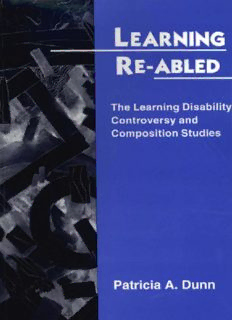
Learning Re-Abled: The Learning Disability Controversy and Composition Studies PDF
Preview Learning Re-Abled: The Learning Disability Controversy and Composition Studies
LEARNING RE-ABLED LEARNING RE-AILED The Learning Disability Controversy and Composition Studies Patricia A. Dunn Utica College of Syracuse University Boynton/Cook Publishers HEINEMANN Portsmouth, NH BoyntonlCook Publishers, Inc. A subsidiary of Reed Elsevier Inc. 361 Hanover Street Portsmouth, NH 03801-3912 Offices and agents throughout the world © 1995 by Patricia A. Dunn. All rights reserved. No part of this book may be reproduced in any form or by any electronic or mechanical means, including information storage and retrieval systems, without permission in writing from the publisher, except by a reviewer, who may quote brief passages in a review. Every effort has been made to contact the copyright holders and students for permission to reprint borrowed material. We regret any oversights that may have occurred and would be happy to rectify them in future printings of this work. Library of Congress Cataloging-in-Publication Data Dunn, Patricia A. Learning re-abled : the learning disability controversy and composition studies / Patricia A. Dunn. p. cm. Includes bibliographical references. ISBN 0-86709-360-9 (alk. paper) 1. Learning disabled-Education (Higher)-United States. 2. Learning disabilities-United States. 3. Dyslexics-Education teaching-United States. 1. Title. LC4818.5.D85 1995 371.91-dc20 95-19316 CIP Editor: Peter R. Stillman Production Editor: Renee M. Nicholls Cover Designer: T. Watson Bogaard Printed in the United States of America on acid-free paper. 99 98 97 96 95 DA 1 2 3 4 5 6 For Joey and Larry Contents Acknowledgments ix Introduction 1 Chapter One Learning Disabilities: The Controversy 9 Chapter Two Gaps in Composition Theory and Practice 45 Chapter Three Multisensory Teaching Methods: Tutoring Joey 75 Chapter Four Learning Differences: The Perspective of LD College Students 96 Chapter Five Implications for College Instructors 154 Conclusion 199 Works Cited 203 vii Acknowledgments I would like to thank my husband Ken Lindblom for his encourage ment, for his enthusiasm about this project, and for his logical and extremely useful readings. I would like to thank my sister Kathy for her wide and varied reading habits, and for her creativity and insight. I am grateful to my mother, Rita Dunn, for reading and commenting on this manuscript in its earliest draft and for her ever present faith in me. I would also like to thank some good friends, Sister Judith Dever, Marie Jordan-Whitney, and Kathleen Thornton Chamberlin, for their confidence in me. I am grateful to Utica Col lege of Syracuse University for giving me a summer grant to work on this book, and especially to Frank Bergmann for supporting all my scholarship at Utica College. I would also like to thank Lil Bran non and Peter Johnston, who gave me productive critiques very early on in this project. lowe a special thanks to Steve North, who helped me immensely with his close, careful readings and candid, thought-provoking observations. His commitment to the field and contribution to it has inspired me. I am also indebted to the many people who allowed me to interview them, especially the three stu dents featured in Chapter Four, who gave so generously of their time and ideas. Finally, I am very grateful to Peter Stillman for his excellent suggestions and the chance to publish this text. ix
Description: